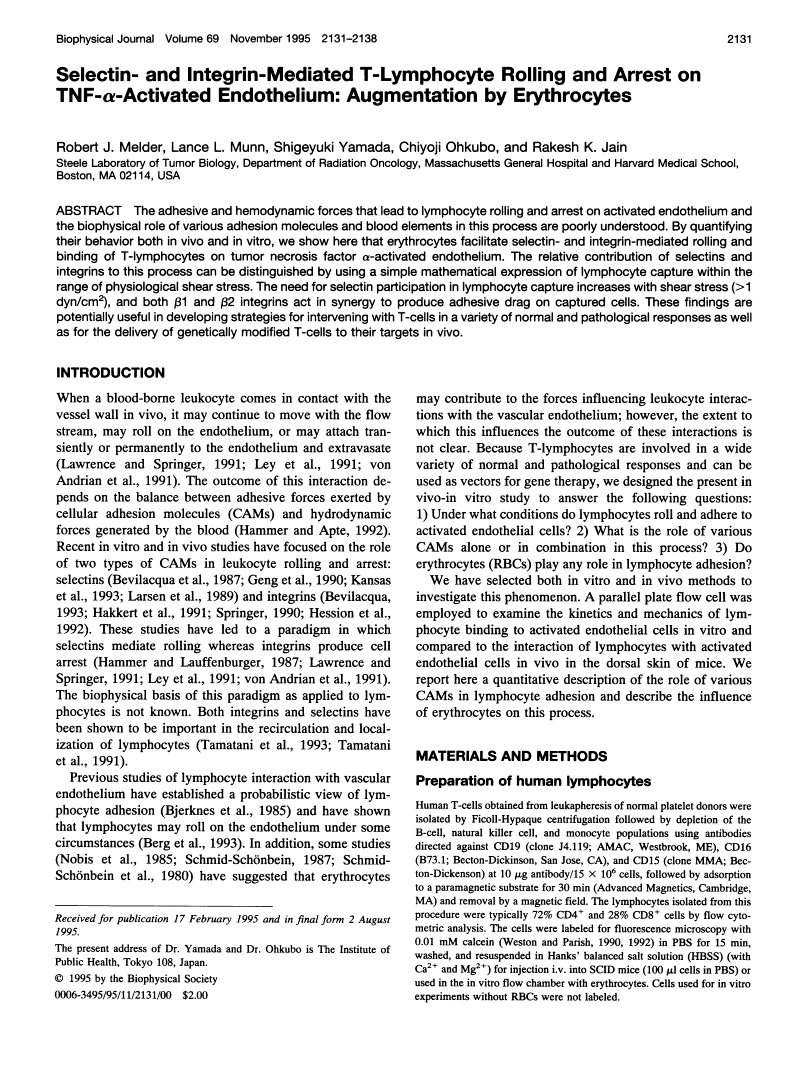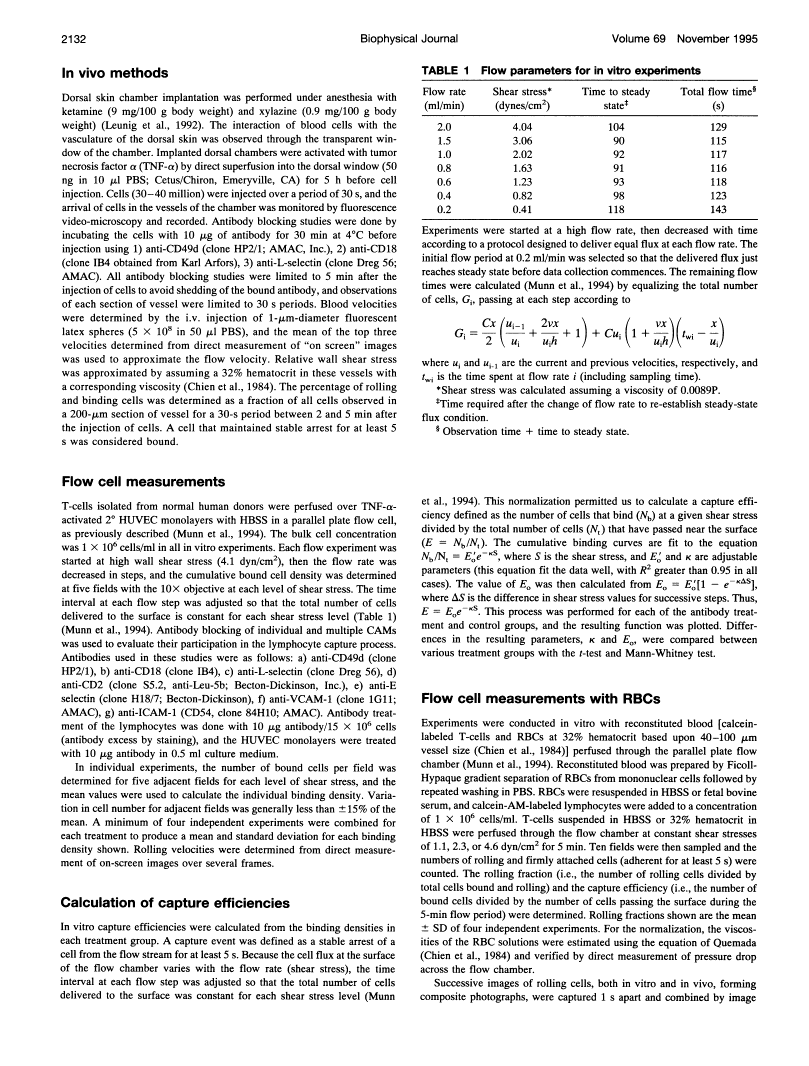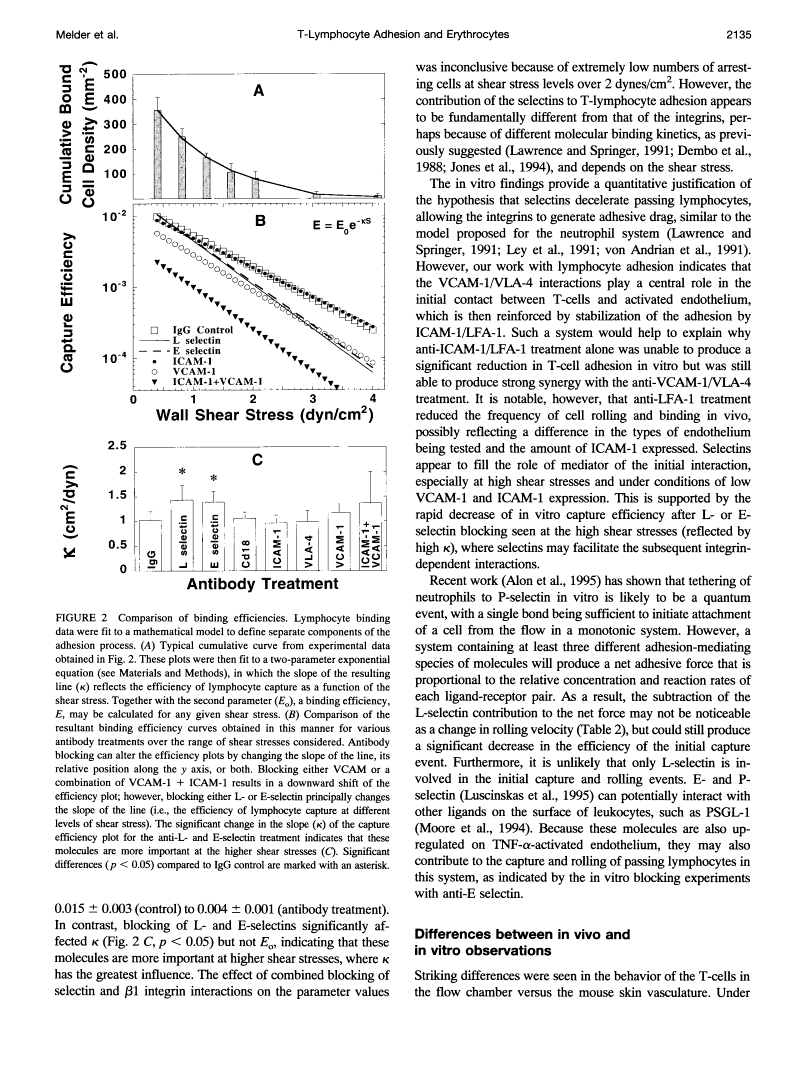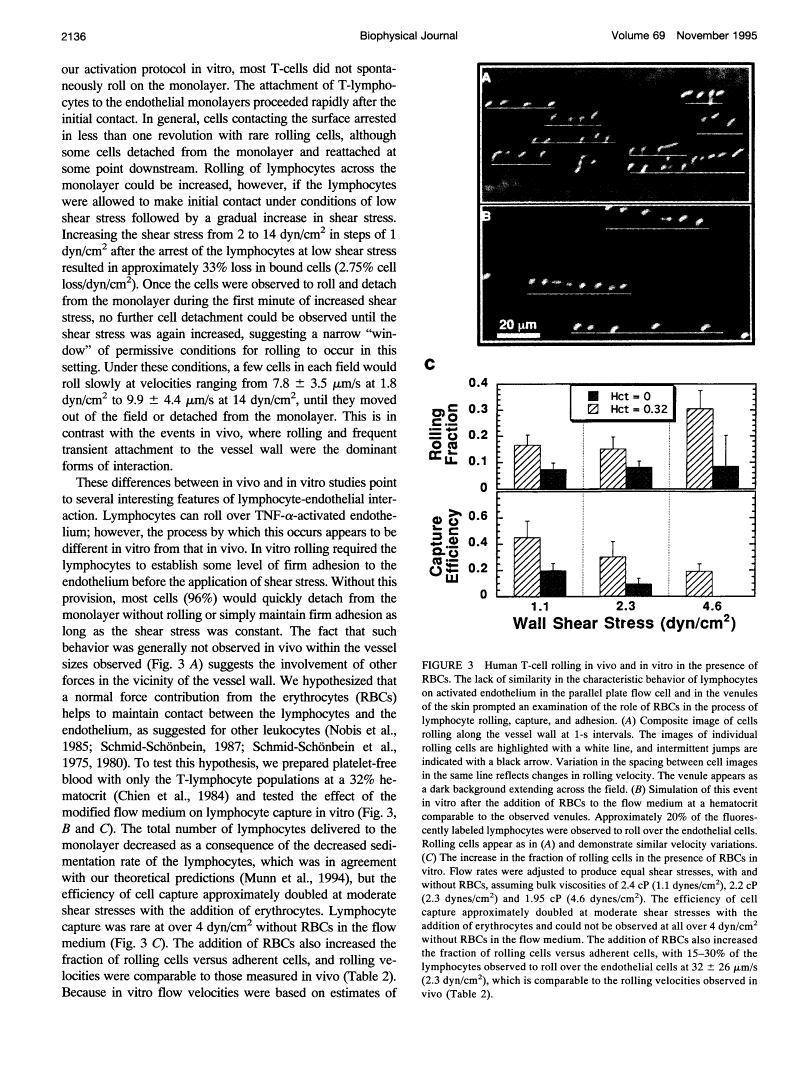Abstract
Free full text

Selectin- and integrin-mediated T-lymphocyte rolling and arrest on TNF-alpha-activated endothelium: augmentation by erythrocytes.
Abstract
The adhesive and hemodynamic forces that lead to lymphocyte rolling and arrest on activated endothelium and the biophysical role of various adhesion molecules and blood elements in this process are poorly understood. By quantifying their behaviour both in vivo and in vitro, we show here that erythrocytes facilitate selectin- and integrin-mediated rolling and binding of T-lymphocytes on tumor necrosis factor alpha-activated endothelium. The relative contribution of selectins and integrins to this process can be distinguished by using a simple mathematical expression of lymphocyte capture within the range of physiological shear stress. The need for selectin participation in lymphocyte capture increases with shear stress (> 1 dyn/cm2), and both beta 1 and beta 2 integrins act in synergy to produce adhesive drag on captured cells. These findings are potentially useful in developing strategies for intervening with T-cells in a variety of normal and pathological responses as well as for the delivery of genetically modified T-cells to their targets in vivo.
Full text
Full text is available as a scanned copy of the original print version. Get a printable copy (PDF file) of the complete article (2.0M), or click on a page image below to browse page by page. Links to PubMed are also available for Selected References.
Images in this article
Selected References
These references are in PubMed. This may not be the complete list of references from this article.
- Alon R, Hammer DA, Springer TA. Lifetime of the P-selectin-carbohydrate bond and its response to tensile force in hydrodynamic flow. Nature. 1995 Apr 6;374(6522):539–542. [Abstract] [Google Scholar]
- Berg EL, McEvoy LM, Berlin C, Bargatze RF, Butcher EC. L-selectin-mediated lymphocyte rolling on MAdCAM-1. Nature. 1993 Dec 16;366(6456):695–698. [Abstract] [Google Scholar]
- Bevilacqua MP. Endothelial-leukocyte adhesion molecules. Annu Rev Immunol. 1993;11:767–804. [Abstract] [Google Scholar]
- Bevilacqua MP, Pober JS, Mendrick DL, Cotran RS, Gimbrone MA., Jr Identification of an inducible endothelial-leukocyte adhesion molecule. Proc Natl Acad Sci U S A. 1987 Dec;84(24):9238–9242. [Europe PMC free article] [Abstract] [Google Scholar]
- Bevilacqua MP, Stengelin S, Gimbrone MA, Jr, Seed B. Endothelial leukocyte adhesion molecule 1: an inducible receptor for neutrophils related to complement regulatory proteins and lectins. Science. 1989 Mar 3;243(4895):1160–1165. [Abstract] [Google Scholar]
- Bjerknes M, Cheng H, Ottaway CA. Dynamics of lymphocyte-endothelial interactions in vivo. Science. 1986 Jan 24;231(4736):402–405. [Abstract] [Google Scholar]
- Dembo M, Torney DC, Saxman K, Hammer D. The reaction-limited kinetics of membrane-to-surface adhesion and detachment. Proc R Soc Lond B Biol Sci. 1988 Jun 22;234(1274):55–83. [Abstract] [Google Scholar]
- Geng JG, Bevilacqua MP, Moore KL, McIntyre TM, Prescott SM, Kim JM, Bliss GA, Zimmerman GA, McEver RP. Rapid neutrophil adhesion to activated endothelium mediated by GMP-140. Nature. 1990 Feb 22;343(6260):757–760. [Abstract] [Google Scholar]
- Goldsmith HL, Spain S. Margination of leukocytes in blood flow through small tubes. Microvasc Res. 1984 Mar;27(2):204–222. [Abstract] [Google Scholar]
- Hakkert BC, Kuijpers TW, Leeuwenberg JF, van Mourik JA, Roos D. Neutrophil and monocyte adherence to and migration across monolayers of cytokine-activated endothelial cells: the contribution of CD18, ELAM-1, and VLA-4. Blood. 1991 Nov 15;78(10):2721–2726. [Abstract] [Google Scholar]
- Hammer DA, Apte SM. Simulation of cell rolling and adhesion on surfaces in shear flow: general results and analysis of selectin-mediated neutrophil adhesion. Biophys J. 1992 Jul;63(1):35–57. [Europe PMC free article] [Abstract] [Google Scholar]
- Hammer DA, Lauffenburger DA. A dynamical model for receptor-mediated cell adhesion to surfaces. Biophys J. 1987 Sep;52(3):475–487. [Europe PMC free article] [Abstract] [Google Scholar]
- Hession C, Moy P, Tizard R, Chisholm P, Williams C, Wysk M, Burkly L, Miyake K, Kincade P, Lobb R. Cloning of murine and rat vascular cell adhesion molecule-1. Biochem Biophys Res Commun. 1992 Feb 28;183(1):163–169. [Abstract] [Google Scholar]
- Jones DA, McIntire LV, Smith CW, Picker LJ. A two-step adhesion cascade for T cell/endothelial cell interactions under flow conditions. J Clin Invest. 1994 Dec;94(6):2443–2450. [Europe PMC free article] [Abstract] [Google Scholar]
- Kansas GS, Ley K, Munro JM, Tedder TF. Regulation of leukocyte rolling and adhesion to high endothelial venules through the cytoplasmic domain of L-selectin. J Exp Med. 1993 Mar 1;177(3):833–838. [Europe PMC free article] [Abstract] [Google Scholar]
- Larsen E, Celi A, Gilbert GE, Furie BC, Erban JK, Bonfanti R, Wagner DD, Furie B. PADGEM protein: a receptor that mediates the interaction of activated platelets with neutrophils and monocytes. Cell. 1989 Oct 20;59(2):305–312. [Abstract] [Google Scholar]
- Lawrence MB, McIntire LV, Eskin SG. Effect of flow on polymorphonuclear leukocyte/endothelial cell adhesion. Blood. 1987 Nov;70(5):1284–1290. [Abstract] [Google Scholar]
- Lawrence MB, Smith CW, Eskin SG, McIntire LV. Effect of venous shear stress on CD18-mediated neutrophil adhesion to cultured endothelium. Blood. 1990 Jan 1;75(1):227–237. [Abstract] [Google Scholar]
- Lawrence MB, Springer TA. Leukocytes roll on a selectin at physiologic flow rates: distinction from and prerequisite for adhesion through integrins. Cell. 1991 May 31;65(5):859–873. [Abstract] [Google Scholar]
- Leunig M, Yuan F, Menger MD, Boucher Y, Goetz AE, Messmer K, Jain RK. Angiogenesis, microvascular architecture, microhemodynamics, and interstitial fluid pressure during early growth of human adenocarcinoma LS174T in SCID mice. Cancer Res. 1992 Dec 1;52(23):6553–6560. [Abstract] [Google Scholar]
- Ley K, Gaehtgens P, Fennie C, Singer MS, Lasky LA, Rosen SD. Lectin-like cell adhesion molecule 1 mediates leukocyte rolling in mesenteric venules in vivo. Blood. 1991 Jun 15;77(12):2553–2555. [Abstract] [Google Scholar]
- Luscinskas FW, Ding H, Lichtman AH. P-selectin and vascular cell adhesion molecule 1 mediate rolling and arrest, respectively, of CD4+ T lymphocytes on tumor necrosis factor alpha-activated vascular endothelium under flow. J Exp Med. 1995 Mar 1;181(3):1179–1186. [Europe PMC free article] [Abstract] [Google Scholar]
- Moore KL, Eaton SF, Lyons DE, Lichenstein HS, Cummings RD, McEver RP. The P-selectin glycoprotein ligand from human neutrophils displays sialylated, fucosylated, O-linked poly-N-acetyllactosamine. J Biol Chem. 1994 Sep 16;269(37):23318–23327. [Abstract] [Google Scholar]
- Munn LL, Melder RJ, Jain RK. Analysis of cell flux in the parallel plate flow chamber: implications for cell capture studies. Biophys J. 1994 Aug;67(2):889–895. [Europe PMC free article] [Abstract] [Google Scholar]
- Nobis U, Pries AR, Cokelet GR, Gaehtgens P. Radial distribution of white cells during blood flow in small tubes. Microvasc Res. 1985 May;29(3):295–304. [Abstract] [Google Scholar]
- Schmid-Schönbein GW. Leukocyte kinetics in the microcirculation. Biorheology. 1987;24(2):139–151. [Abstract] [Google Scholar]
- Schmid-Schoenbein GW, Fung YC, Zweifach BW. Vascular endothelium-leukocyte interaction; sticking shear force in venules. Circ Res. 1975 Jan;36(1):173–184. [Abstract] [Google Scholar]
- Schmid-Schönbein GW, Sung KL, Tözeren H, Skalak R, Chien S. Passive mechanical properties of human leukocytes. Biophys J. 1981 Oct;36(1):243–256. [Europe PMC free article] [Abstract] [Google Scholar]
- Schmid-Schönbein GW, Usami S, Skalak R, Chien S. The interaction of leukocytes and erythrocytes in capillary and postcapillary vessels. Microvasc Res. 1980 Jan;19(1):45–70. [Abstract] [Google Scholar]
- Springer TA. Adhesion receptors of the immune system. Nature. 1990 Aug 2;346(6283):425–434. [Abstract] [Google Scholar]
- Tamatani T, Kuida K, Watanabe T, Koike S, Miyasaka M. Molecular mechanisms underlying lymphocyte recirculation. III. Characterization of the LECAM-1 (L-selectin)-dependent adhesion pathway in rats. J Immunol. 1993 Mar 1;150(5):1735–1745. [Abstract] [Google Scholar]
- Tamatani T, Kotani M, Tanaka T, Miyasaka M. Molecular mechanisms underlying lymphocyte recirculation. II. Differential regulation of LFA-1 in the interaction between lymphocytes and high endothelial cells. Eur J Immunol. 1991 Mar;21(3):855–858. [Abstract] [Google Scholar]
- von Andrian UH, Chambers JD, McEvoy LM, Bargatze RF, Arfors KE, Butcher EC. Two-step model of leukocyte-endothelial cell interaction in inflammation: distinct roles for LECAM-1 and the leukocyte beta 2 integrins in vivo. Proc Natl Acad Sci U S A. 1991 Sep 1;88(17):7538–7542. [Europe PMC free article] [Abstract] [Google Scholar]
- Weston SA, Parish CR. New fluorescent dyes for lymphocyte migration studies. Analysis by flow cytometry and fluorescence microscopy. J Immunol Methods. 1990 Oct 4;133(1):87–97. [Abstract] [Google Scholar]
- Weston SA, Parish CR. Calcein: a novel marker for lymphocytes which enter lymph nodes. Cytometry. 1992;13(7):739–749. [Abstract] [Google Scholar]
- Yan HC, Delisser HM, Pilewski JM, Barone KM, Szklut PJ, Chang XJ, Ahern TJ, Langer-Safer P, Albelda SM. Leukocyte recruitment into human skin transplanted onto severe combined immunodeficient mice induced by TNF-alpha is dependent on E-selectin. J Immunol. 1994 Mar 15;152(6):3053–3063. [Abstract] [Google Scholar]
Associated Data
Articles from Biophysical Journal are provided here courtesy of The Biophysical Society
Citations & impact
Impact metrics
Citations of article over time
Article citations
Red blood cell distribution width is associated with increased interactions of blood cells with vascular wall.
Sci Rep, 12(1):13676, 11 Aug 2022
Cited by: 19 articles | PMID: 35953533 | PMCID: PMC9366818
Investigating the Interaction Between Circulating Tumor Cells and Local Hydrodynamics via Experiment and Simulations.
Cell Mol Bioeng, 13(5):527-540, 21 Oct 2020
Cited by: 6 articles | PMID: 33184581 | PMCID: PMC7596168
VCAM-1 Density and Tumor Perfusion Predict T-cell Infiltration and Treatment Response in Preclinical Models.
Neoplasia, 21(10):1036-1050, 11 Sep 2019
Cited by: 13 articles | PMID: 31521051 | PMCID: PMC6744528
Dependence of leukocyte capture on instantaneous pulsatile flow.
J Biomech, 76:84-93, 15 Jun 2018
Cited by: 1 article | PMID: 29914741 | PMCID: PMC6103190
Reengineering the Physical Microenvironment of Tumors to Improve Drug Delivery and Efficacy: From Mathematical Modeling to Bench to Bedside.
Trends Cancer, 4(4):292-319, 13 Mar 2018
Cited by: 206 articles | PMID: 29606314 | PMCID: PMC5930008
Review Free full text in Europe PMC
Go to all (50) article citations
Similar Articles
To arrive at the top five similar articles we use a word-weighted algorithm to compare words from the Title and Abstract of each citation.
Characterization of eosinophil adhesion to TNF-alpha-activated endothelium under flow conditions: alpha 4 integrins mediate initial attachment, and E-selectin mediates rolling.
J Immunol, 163(1):343-350, 01 Jul 1999
Cited by: 16 articles | PMID: 10384134
P-selectin and vascular cell adhesion molecule 1 mediate rolling and arrest, respectively, of CD4+ T lymphocytes on tumor necrosis factor alpha-activated vascular endothelium under flow.
J Exp Med, 181(3):1179-1186, 01 Mar 1995
Cited by: 120 articles | PMID: 7532680 | PMCID: PMC2191919
Role of erythrocytes in leukocyte-endothelial interactions: mathematical model and experimental validation.
Biophys J, 71(1):466-478, 01 Jul 1996
Cited by: 73 articles | PMID: 8804629 | PMCID: PMC1233497
Possible steps involved in the transition to stationary adhesion of rolling neutrophils: a brief review.
Microcirculation, 7(6 pt 1):385-394, 01 Dec 2000
Cited by: 12 articles | PMID: 11142335
Review













